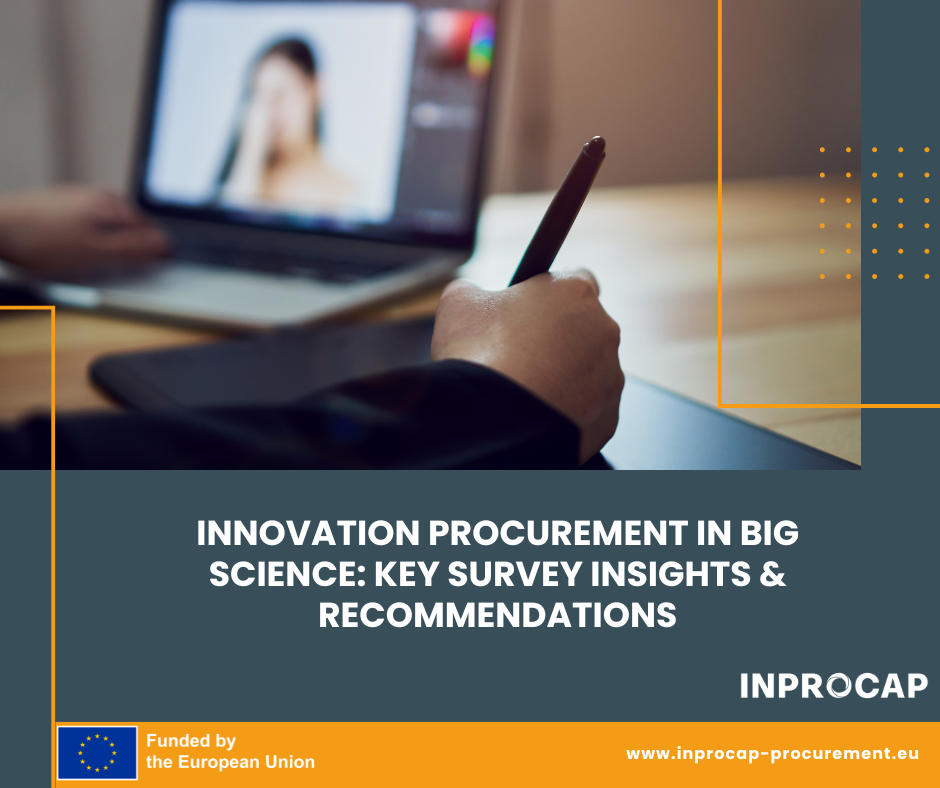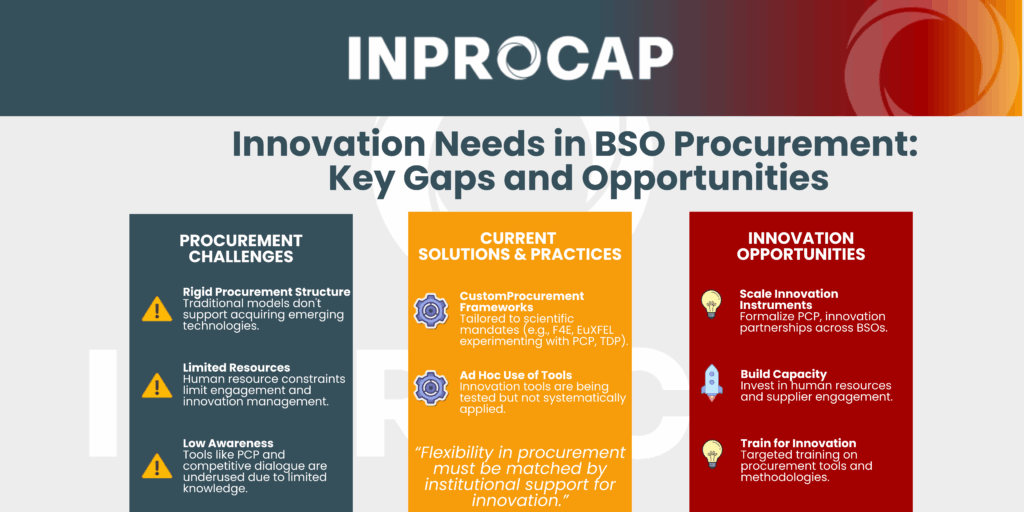As Big Science Organizations (BSOs) increasingly depend on advanced technologies, procurement is evolving from a transactional role to a strategic driver of innovation. To explore how procurement can better support innovation, a survey conducted by INPROCAP partners in late 2024 and early 2025 gathered insights through structured interviews with BSO professionals. The findings highlight common challenges, effective practices, and opportunities to strengthen collaboration with suppliers—ultimately aiming to accelerate scientific progress through smarter procurement strategies.

Identifying Innovation Needs
The interviews highlighted that BSOs often operate under tailored procurement frameworks aligned with their legal mandates and scientific missions. While this autonomy provides flexibility, it also reveals gaps where more innovation-oriented tools and approaches are necessary. Key findings included:
- Demand for Adaptable Procurement Instruments
Many BSOs find that traditional procurement processes are not designed for acquiring novel technologies. Organizations such as F4E and EuXFEL are testing tools like pre-commercial procurement (PCP), technology development programmes (TDP), and innovation partnerships. There is a growing consensus on the need to formalize and scale these instruments across institutions.
- Resource Constraints in Innovation Procurement
BSOs such as ESS, ESRF, and EISCAT report limitations in human resources, which restrict their ability to engage with suppliers, conduct market analysis, and manage innovation-oriented projects. These constraints hinder their capacity to effectively scout and integrate innovative solutions.
- Limited Awareness of Innovation Tools
Despite the existence of effective mechanisms like competitive dialogue and PCP, several BSOs expressed limited familiarity with how and when to use them. This highlights the need for targeted training and knowledge-building in innovation procurement methods.

Lessons Learned
Beyond individual challenges, the survey surfaced common lessons learned across organizations:
- Cultural Resistance to External Innovation: Institutions with robust in-house R&D—such as ILL and CERN—sometimes show reluctance to procure externally developed technologies. Bridging this gap requires stronger cross-functional collaboration among engineers, legal experts, and procurement officers.
- Legal Complexity and Risk Aversion: Extended contract negotiations, intellectual property issues, and risk management concerns often discourage innovative procurement. BSOs like EuXFEL and F4E flagged this as a major bottleneck.
- Uncertainty in Budgeting for Innovation: Innovation projects often involve longer timelines and unpredictable costs, which can conflict with budgetary planning. To mitigate this, milestone-based contracts are recommended as a way to align risk with measurable progress.
Recommendations for Future Practice
To overcome these barriers and build more agile innovation ecosystems, the findings support a series of actionable recommendations:
- Embrace Functional Specifications: Focus on performance outcomes rather than prescribing technical solutions to allow more creative and innovative responses from suppliers.
- Enhance Supplier Engagement: Use pre-tender activities like industry days, market surveys, and consultations to shape clearer, more effective procurement scopes.
- Facilitate SME Participation: Simplify documentation, allow advance payments, and split contracts to make opportunities more accessible to small and medium enterprises.
- Establish Shared Innovation Platforms: A centralized, BSO-wide supplier portal would improve supplier visibility and help align cross-institutional procurement efforts.
- Invest in Training and Knowledge Sharing: Regular training on innovation procurement tools, legal risk management, and contract design will build institutional capacity.
- Document and Share Case Studies: Creating a shared library of successful innovation procurement examples can help BSOs learn from one another and replicate success.
Conclusion
The findings from the survey of BSO procurement officers underline both the opportunities and the systemic barriers in innovation procurement. By addressing these challenges—through capacity building, shared tools, and cultural change—BSOs can significantly enhance their ability to source and co-develop cutting-edge technologies. In doing so, they not only fulfill their missions but also strengthen innovation ecosystems across Europe and beyond.




